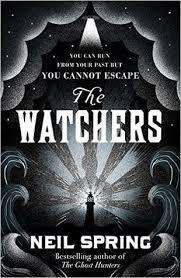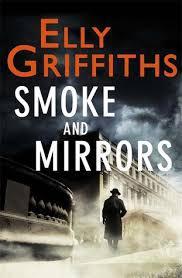 The Watchers by Neil Spring is based on a series of real and unexplained events near the coast of Wales in the late 1970s. In the winter of 1977 a spate of UFO sightings took place, the most compelling witnessed by the children of a primary school who believed strongly that they saw a spacecraft land, whilst others were convinced they had seen giant silver-suited figures staring in windows. There was so much media concern over the sightings that the Ministry of Defence secretly conducted research into the area, though what their officials made of it is still unknown. I was a child of the 70s and the premise of the novel sparked long-buried memories of those UFO sightings. It struck me as an intriguing idea to go back to that era and to resurrect the old UFO concept – but although the novel begins there, it isn’t quite where the story ends up.
The Watchers by Neil Spring is based on a series of real and unexplained events near the coast of Wales in the late 1970s. In the winter of 1977 a spate of UFO sightings took place, the most compelling witnessed by the children of a primary school who believed strongly that they saw a spacecraft land, whilst others were convinced they had seen giant silver-suited figures staring in windows. There was so much media concern over the sightings that the Ministry of Defence secretly conducted research into the area, though what their officials made of it is still unknown. I was a child of the 70s and the premise of the novel sparked long-buried memories of those UFO sightings. It struck me as an intriguing idea to go back to that era and to resurrect the old UFO concept – but although the novel begins there, it isn’t quite where the story ends up.
Robert Wilding is a tortured man. He suffers from anxiety and OCD, a legacy of the traumatic deaths of his parents in a flood and from the fear-fuelled adolescence he spent with his religious extremist grandfather in Wales. Even now as a grown man his nightmares and worst fantasies concern ominous pounding on doors and the need to hide from the Watchers, whoever or whatever they may be. He’s trying to do his best to right the wrongs of the past, however, through his government job. His father worked in the military and his mother was a protestor, so both were caught up in the events at RAF Croughton in 1963, when a demonstration went wrong and his mother was badly burned in the subsequent fire. Now, in 1977, with the help of the local Welsh MP, Robert is involved in the government enquiry into this event. When the enquiry is disrupted in a catastrophic way, the American Lieutenant Colonel who Robert was hoping to see in the witness box contacts him to arrange a midnight meeting. He suggests that the UFO sightings in the area are not in fact extraterrestial in nature, but high-tech surveillance from Russia. When Robert’s mentor in the government also encourages him to return to Wales to look more closely into what’s happening at the American and British bases, Robert must swallow his personal fears for the greater cause.
What he finds in Wales is a community living in extreme fear. Along with unexplained sightings such a balls of fire that travel as fast as a car, there have been animal mutilations and a strange sickness that sounds like radiation poisoning. Robert is forced to confront his grandfather and his memories of the past, but what is more alarming, he is beginning to understand his grandfather’s point of view. From here on in, events spiral into a waking nightmare in which no one is what they seem.
Having begun this thinking it would be a sort of thriller-ish affair, it turned out to belong much more readily to the horror genre or the book form of the disaster movie. There’s a lot going on and a great deal happens, each short chapter containing some incident that ratchets up the tension, resulting in a taut and compelling plot. However, I have to confess that I think I’m a bit old for this novel. If you love the kind of rapid-fire plotting that dominates a lot of current television and film, you’ll really get behind this. Me, I’m old school, so I would have liked to see more characterisation. If your main character begins the novel traumatised, is then thrown into the depths of his fears and never really has a chance to catch his breath, you don’t see many sides of his personality. I’m also not a believer in the paranormal. The thought that the UFO sightings might be military-based excited me; I love that sort of clever rational explanation, but quite quickly we are moved onto other, darker motivations. Essentially, I suppose the novel explores dangerous hypnotic beliefs, either in the form of satanic rites or mass hysteria. I fell out of the fantasy frame about halfway through and struggled to get back into it. I think it’s a good book; well-written, very well plotted, and conceptually it holds together on its own terms. You have to decide if the subject matter is up your dark and menacing alley or not.

But the solution to the crime may lie instead with the adult theater troupe performing pantomime. Those with longer memories can still recall a murder that took place in the same venue in 1912, when a young girl, a Babe in the Wood, is found with her throat cut. By uncanny coincidence, several of the 1951 cast have family links back to that earlier play and the earlier unsolved crime. Could the police be dealing with a copycat situation?
For some reason or other, I had it in my head that Elly Griffiths didn’t write very good prose, and so I hadn’t read her before. This turns out to be a complete nonsense – Smoke and Mirrors was a very well-written book with an especially nice line in dialog. Max Mephisto gets all the fun character attributes, being dramatic, egotistic and a tad louche; poor old Edgar is the worrywort with a tricky conscience. Edgar also has two promising henchmen, the dour, class-conscious Bob, and bright, moneyed Emma (who is treated in a way that will please all 21st century sensibilities, though somewhat anachronistic to the 50s setting). This was a well-conceived and highly atmospheric story, and my only real criticism is that by the three-quarters mark we still had absolutely no idea what had happened and not much to show for the efforts of the police. That’s not unusual in contemporary crime fiction, however, and it didn’t mess with my motivation. I found this a compelling novel and in fact have since begun on the Ruth Galloway series (I read The House at Sea’s End which was even better than this one). If you like crime fiction, Griffiths is definitely worth a try.
